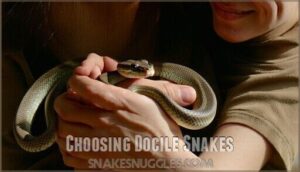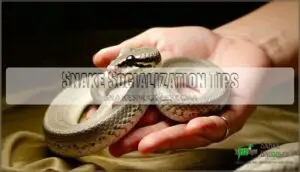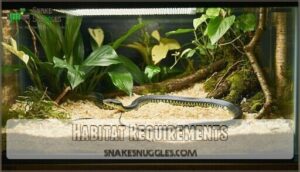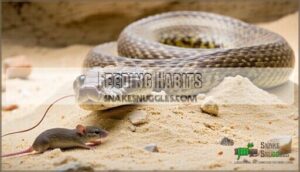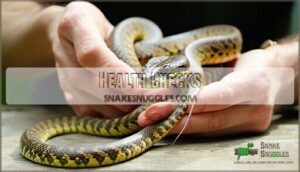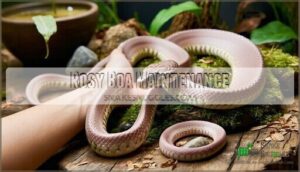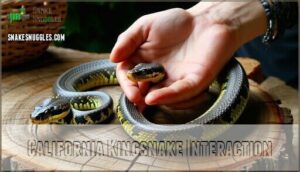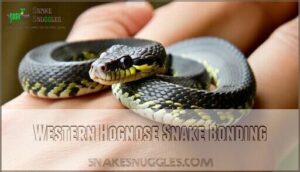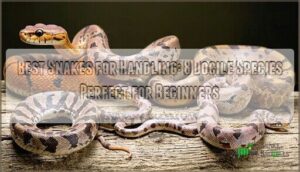This site is supported by our readers. We may earn a commission, at no cost to you, if you purchase through links.

Corn snakes top the list—they’re calm, manageable-sized, and rarely bite.
Ball pythons are gentle giants that often curl into a ball when nervous rather than striking.
Rosy boas stay small and have mellow temperaments, while California kingsnakes are surprisingly tolerant despite their bold hunting nature.
Western hognose snakes are dramatic but harmless, often playing dead rather than biting.
Each species has unique care requirements and personality quirks that’ll influence your bonding experience.
Table Of Contents
- Key Takeaways
- Snake Species Overview
- Choosing Docile Snakes
- Snake Socialization Tips
- Caring for Cuddly Snakes
- Popular Snakes for Cuddling
- Frequently Asked Questions (FAQs)
- Which snakes are the best Cuddle Buddies for beginners?
- What are the best pet snakes for beginners?
- Which snakes are beginner-friendly?
- What are the most docile snakes?
- Are snakes good pets?
- Are snakes friendly?
- What is the best snake for cuddling?
- What’s the friendliest snake to have as a pet?
- What snakes bond with humans?
- Can you cuddle with a pet snake?
- Conclusion
Key Takeaways
- Choose docile breeds like corn snakes and ball pythons – these species naturally have calm temperaments and rarely bite, making them ideal for gentle handling and building trust through regular interaction.
- Start with proper socialization techniques – you’ll need to move slowly, speak softly, and let your snake get comfortable with your presence before attempting physical contact to build genuine trust.
- Create the right environment first – your snake won’t be receptive to cuddling if their habitat lacks proper temperature gradients (75-90°F), humidity levels (40-80%), and adequate space for security.
- Watch for stress signals during handling – you should immediately recognize signs like hissing, tail vibrations, or excessive hiding, which means your snake needs space rather than interaction time.
Snake Species Overview
If you’re looking for a snake that enjoys gentle handling, you’ll want to focus on species known for their calm temperaments and tolerance for human interaction.
These five breeds stand out for their docile nature and willingness to be handled, making them excellent choices for snake enthusiasts who want a more interactive pet experience.
Corn Snake Characteristics
When you’re hunting for corn snakes, you’ll discover nature’s perfect "starter snake" with their stunning color patterns ranging from vibrant orange to subtle gray.
These docile snake species showcase remarkable temperament traits that make snake cuddling surprisingly enjoyable.
Here are three standout corn snake characteristics:
- Snake size: Adults reach 2-6 feet, perfect for comfortable handling
- Gentle temperament: Naturally curious yet non-aggressive disposition
- Habitat needs: Simple 30-gallon setup with proper temperature zones
Their distinctive checkerboard belly pattern and iridescent scales create visual appeal, while their manageable size makes handling tips unnecessary for most owners.
These cuddly snakes demonstrate spatial learning abilities rivaling birds, proving intelligence beyond their calm demeanor.
Understanding their ecological importance is essential for appreciating their role in the ecosystem.
Ball Python Temperament
Ball Python’s gentle temperament makes it the ultimate cuddly snake species for beginners.
These gentle giants truly deserve their reputation as perfect starter snakes for handling enthusiasts.
You’ll find these docile snake species incredibly tolerant of Snake Trust building through regular Ball Python Handling sessions.
Their Python Behavior shows remarkable calmness—they rarely bite and actually seem to enjoy gentle interactions. Different Temperament Types exist, but most ball pythons display consistent gentle temperament perfect for snake cuddling adventures.
California Kingsnake Behavior
California Kingsnakes make excellent companions for snake enthusiasts seeking docile snake species that actually enjoy gentle snakes interaction.
Their curious nature and mild temperament create perfect conditions for snake cuddling experiences.
- Kingsnake Habitat adaptability – They thrive in various environments, making setup easier for you
- Intelligent curiosity – Your California Kingsnake will actively explore and investigate their surroundings
- Kingsnake Diet simplicity – They readily accept frozen-thawed rodents without fussing
- Natural snake affection – These reptiles genuinely seem to enjoy human interaction and handling sessions
Rosy Boa Personality
When you’re seeking a snake that embodies tranquility, the Rosy Boa’s temperament makes it perfect for gentle handling and snake cuddling.
These docile snake species naturally exhibit calm nature, making boa socialization effortless, and their snake affection shows through relaxed body language during interactions.
Gentle snakes like Rosy Boas rarely stress, creating ideal conditions for reptile affection and bonding experiences.
Understanding the rosy boa temperament is key to building a strong connection with these animals.
Western Hognose Snake Traits
Western hognose snakes stand out as the gentle giants of docile snake species, making them perfect cuddly reptiles for beginners.
These dramatic little actors combine genuine sweetness with entertaining personalities that make handling sessions feel like quality time with a quirky friend.
Their snake temperament combines curiosity with calmness, creating ideal conditions for pet bonding through gentle handling.
- Hognose habitat needs – Simple 20-gallon setup with proper heating
- Snake nutrition requirements – Small rodents every 7-10 days
- Hognose health indicators – Active behavior and regular shedding cycles
Choosing Docile Snakes
Selecting the right snake species requires careful evaluation of temperament, care requirements, and handling tolerance.
You’ll want to research each species’ behavioral patterns and consult experienced breeders who can guide you toward naturally docile individuals.
Researching Species
Before diving into specific docile snake species, you’ll want to thoroughly research each breed’s unique temperament and care requirements.
Species selection involves examining snake temperament data, handling techniques compatibility, and pet suitability factors.
Proper breed research helps you identify cuddly reptiles that match your experience level and living situation, ensuring successful snake companionship and socialization opportunities.
Consulting Experts
Before making your final choice, connect with reptile consultants and herpetologist insights from local veterinary clinics.
Snake specialists provide expert advice on which docile breeds suit your lifestyle best.
Breeder interviews reveal how gentle each species truly behaves during bonding sessions.
Snake enthusiasts’ firsthand experiences with cuddling different breeds offer invaluable guidance for choosing your perfect companion.
Understanding the importance of snake cuddling techniques is essential for building a strong bond with your pet snake.
Observing Behavior
When observing snake behavior, you’ll need to watch for specific body language cues that reveal their temperament.
Look for relaxed snake posture with loose coils rather than tight defensive positioning.
Gentle movement patterns and steady eye contact indicate a docile nature perfect for cuddling and bonding.
Notice how tail signs like gentle swaying versus aggressive whipping reveal their comfort level during handling interactions, which can signify a comfort level.
Environmental Needs
Once you’ve spotted that perfect snake personality, you’ll need to create the right snake environment to keep them comfortable and cuddly.
A proper snake enclosure requires specific environmental conditions that directly impact your snake’s willingness to interact with you.
Consider these critical snake habitat requirements:
- Temperature Control: Maintain 10-15°F gradient with basking spots at species-specific temperatures
- Humidity Levels: Keep 40-80% depending on species, with higher levels during shedding periods
- Spatial Needs: Provide enclosures at least 2/3 your snake’s body length for adequate movement
- Ventilation Systems: Guarantee proper airflow to prevent respiratory issues and bacterial growth
- Lighting Requirements: Use appropriate day/night cycles without excessive heat from lighting fixtures
Getting reptile care basics right means your snake will feel secure enough to enjoy handling sessions with you.
Handling Techniques
Once you’ve created the right environment, proper snake handling techniques become your pathway to building genuine trust.
Support your snake’s entire body with calm movements and a soft touch – never grab or squeeze.
Mastering safe handling techniques, such as proper snake support, is essential for a stress-free interaction.
| Gentle Handling Basics | Trust Building Methods |
|---|---|
| Support full body length | Move slowly and deliberately |
| Use both hands for security | Let snake explore your hands |
| Keep movements predictable | Handle during active periods |
These reptile handling fundamentals help docile snakes feel secure while you develop your handling skills together.
Snake Socialization Tips
Successful snake socialization starts with understanding your pet’s unique personality and stress signals before you begin any handling attempts.
You’ll build the strongest bond by moving slowly, speaking softly, and allowing your snake to become comfortable with your presence near their enclosure before progressing to gentle physical contact.
Building Trust
Trust Building begins with consistent, predictable interactions that help your snake recognize you as safe rather than threatening.
You’ll create a Calm Environment by moving slowly around their enclosure and speaking softly during routine care.
Through Gentle Handling sessions, these reptile socialization efforts teach your snake that human contact means safety, not danger.
This Snake Recognition process transforms nervous serpents into trusting gentle giants.
Gentle Approach
When approaching your snake, slow and deliberate movements work like magic for Snake Handling success.
Your gentle approach sets the foundation for Trust Building through Calm Movements and Soft Touch techniques.
Move deliberately, avoiding sudden gestures that might startle your docile companion.
This Gentle Interaction creates positive associations, making your tame snake more receptive to future reptile cuddling sessions and advancing snake socialization effectively.
Calm Movements
Your snake responds best when you move with deliberate slowness during interactions. Quick gestures can trigger defensive responses, while steady, predictable movements help build trust.
Keep your Calm Posture relaxed and avoid sudden direction changes that might startle your docile companion. This Slow Approach creates the foundation for positive Gentle Handling sessions with your tame pet.
Mastering safe snake handling methods, such as using proper handling techniques, is essential for a stress-free experience.
Soft Interactions
Once you’ve established calm handling routines, you’ll want to incorporate gentle touch techniques that build deeper trust with your docile snake.
Use light fingertip pressure along their body—think snake massage rather than firm gripping.
This sensory stimulation helps cuddly reptiles associate your presence with comfort.
Tame reptiles respond beautifully to consistent, soft interactions that demonstrate your peaceful intentions and foster genuine snake affection.
Recognizing Stress Signs
While building comfort with gentle handling, you’ll need to watch for specific stress signals that indicate your docile snake needs space.
Reading your snake’s body language becomes second nature once you understand their communication style.
Watch for these key stress signals:
- Hissing signs – defensive vocalizations paired with mock striking behavior
- Tail vibrations – rapid shaking that mimics rattlesnake warnings
- Clutching behavior – tightly coiling around your hand or arm
- Head retraction – pulling back defensively when approached
- Excessive hiding – spending abnormal amounts of time buried or withdrawn
Snake behavior tells you everything about their comfort level during handling sessions.
Caring for Cuddly Snakes
Once you’ve chosen your gentle serpent companion, proper care becomes essential for maintaining their docile nature and overall health.
You’ll need to master habitat setup, feeding schedules, and temperature management to keep your snake comfortable and ready for those relaxing handling sessions, which involves understanding the importance of proper care.
Habitat Requirements
Creating your snake’s perfect home means balancing several key factors.
You’ll need proper enclosure size (minimum 40 gallons for adults), temperature control with basking spots at 88-92°F, and humidity levels between 50-60%.
Choose appropriate substrate options like aspen shavings, make certain adequate lighting needs with day/night cycles, and design a secure environment.
Your snake habitat becomes their safe haven when these reptile care techniques prioritize snake comfort above all else.
Proper snake enclosure designs are vital for maintaining a healthy and thriving snake.
Feeding Habits
Proper nutrition transforms your gentle giant into a thriving companion. You’ll need to establish consistent Food Sources and Feeding Times that match your snake’s natural rhythms.
Most docile snakes thrive on pre-killed frozen rodents, making snake feeding straightforward and safe.
Diet Plans for your cuddly companion:
- Prey Items: Offer appropriately-sized frozen/thawed mice or rats
- Feeding Times: Schedule meals every 7-14 days for adults
- Nutrient Needs: Provide whole prey for complete nutrition
- Food Sources: Source from reputable reptile suppliers
- snake care tips: Monitor feeding response and adjust portions accordingly
Health Checks
You’ll want to monitor your snake’s wellbeing through regular observations and professional checkups.
Annual veterinary visits help catch hidden issues early, while weekly Essential Sign Monitoring at home tracks changes in behavior and appetite.
| Health Check Area | What to Look For |
|---|---|
| Eye Condition | Clear, bright eyes; sunken or cloudy eyes signal dehydration |
| Mouth Examination | Pink, moist mouth; white patches or swelling indicate infection |
| Scale Health | Smooth, intact scales; blisters or retained skin need attention |
| Parasite Inspection | Check for mites around eyes and heat pits |
| Body Condition | Firm muscle tone; limpness suggests illness or temperature issues |
Watch for respiratory symptoms like wheezing or mouth breathing, which require immediate veterinary care.
Your snake’s trust in you makes these health assessments easier and less stressful.
Enclosure Design
Design your snake enclosure like a cozy studio apartment—spacious yet secure.
You’ll need adequate habitat size (40+ gallons for most species), proper ventilation systems to prevent stagnant air, and strategic lighting options.
Create temperature gradients from warm to cool zones, while maintaining humidity control between 50-60%.
Your reptile care success depends on this thoughtfully planned snake environment.
Proper snake enclosure design requires consideration of snake habitat needs to guarantee the health and well-being of your pet.
Temperature Control
Temperature regulation makes the difference between a stressed snake and a happy, handleable companion. Your snake’s thermal environment directly impacts their behavior, digestion, and willingness to interact with you.
- Heat sources: Use ceramic heat emitters or under-tank heating pads for consistent warmth
- Thermal gradients: Create a basking spot (85-90°F) and cool side (75-80°F) in your snake enclosure
- Temperature ranges: Ball pythons need 78-80°F cool side, while corn snakes prefer 75-85°F overall
- Humidity levels: Maintain 50-60% for most species using water bowls and substrate
- Heating elements: Install thermostats to prevent overheating and maintain snake health
Monitor temperatures daily with digital thermometers to verify your snake feels secure enough for gentle handling sessions. Proper thermostat settings are vital for maintaining a stable snake temperature control system in the enclosure.
Popular Snakes for Cuddling
When you’re ready to experience the joy of handling these gentle serpents, you’ve got five standout species that truly shine with regular interaction.
Each of these snake breeds offers a unique combination of calm temperament and tolerance for human contact that makes them perfect companions for cuddling sessions.
They are ideal for cuddling sessions because of their gentle nature.
Corn Snake Care
Corn feeding success starts with understanding your snake’s appetite schedule—juveniles eat weekly while adults manage every 10-14 days.
You’ll want snake housing that’s spacious (30+ gallons) with secure lids since corn snakes are escape artists.
Humidity control stays simple at 40-60%, while temperature management requires a basking spot of 85°F.
These docile snakes make snake handling enjoyable with proper snake care techniques.
Ball Python Handling
Ball pythons earn their reputation as the ultimate cuddly reptiles through their remarkably docile temperament.
These gentle giants respond beautifully to consistent Python Taming efforts when you follow proper Snake Handling Tips.
- Handle 1-2 times weekly with Gentle Touch movements
- Wait two days after feeding before any snake handling
- Support their entire body during Handling Techniques sessions
- Keep interactions short (5-10 minutes) for effective snake bonding
Your ball python’s calm nature makes Ball Python Care rewarding for beginners seeking docile snakes.
Rosy Boa Maintenance
Maintaining your Rosy Boa becomes second nature with their easygoing requirements.
You’ll need proper Rosy Boa Diet of appropriately sized rodents every two weeks, while Tank Cleaning stays minimal with spot-cleaning as needed.
Humidity Control remains simple at 30-50%, and Boa Substrate like aspen shavings works perfectly.
Snake Lighting isn’t mandatory, making these docile snakes ideal cuddly reptiles for beginners seeking gentle snake bonding experiences.
California Kingsnake Interaction
When you’re ready to build that special connection, California Kingsnake interaction becomes surprisingly rewarding for snake lovers seeking docile companions.
These gentle serpents develop snake recognition abilities, remembering their handlers through consistent, patient interaction tips.
Kingsnake temperament naturally leans toward curiosity rather than aggression, making kingsnake handling sessions feel less like wrestling matches and more like peaceful conversations.
Kingsnake trust builds gradually through respectful snake interaction techniques.
Western Hognose Snake Bonding
Your Western Hognose Snake will surprise you with their theatrical personalities and genuine affection potential.
These docile performers respond beautifully to gentle care and consistent hognose handling techniques.
Snake trust develops quickly when you respect their unique snake temperament traits—they’ll even "play dead" dramatically.
With proper bonding tips and patience, your Western Hognose Snake becomes remarkably responsive to snake affection through gentle interactions and snake bonding sessions.
Understanding their hognose snake behavior is essential for building a strong bond with your pet, based on proper bonding tips.
Frequently Asked Questions (FAQs)
Which snakes are the best Cuddle Buddies for beginners?
Ironically, the most "cuddly" serpents aren’t traditional lap pets, but corn snakes and ball pythons make excellent beginner companions.
You’ll find these docile species tolerate gentle handling beautifully, creating surprisingly intimate bonds through patient interaction.
What are the best pet snakes for beginners?
Corn snakes, ball pythons, and rosy boas make excellent beginner pets.
They’re docile, easy to handle, and forgiving of care mistakes.
You’ll find them calm, predictable, and surprisingly tolerant of gentle interaction.
Which snakes are beginner-friendly?
Like finding your perfect dance partner, choosing beginner-friendly snakes requires matching temperament with your comfort level.
Corn snakes, ball pythons, and rosy boas offer docile personalities, manageable sizes, and forgiving care requirements that’ll build your confidence.
What are the most docile snakes?
Ball pythons, corn snakes, and rosy boas top the docility charts.
These gentle giants rarely bite, tolerate handling well, and stay calm under pressure.
Their even temperaments make them perfect companions for beginners.
Are snakes good pets?
Slithering companions aren’t everyone’s cup of tea, but you’ll find they make surprisingly rewarding pets.
Captive-bred species like corn snakes and ball pythons develop docile temperaments, recognize their owners, and require minimal daily care compared to traditional pets.
Are snakes friendly?
Yes, snakes can be friendly!
Many captive-bred species like corn snakes and ball pythons recognize their owners, tolerate gentle handling, and show calm behavior when properly socialized through patience and respect.
What is the best snake for cuddling?
Ball pythons excel at cuddling—they’re calm, enjoy warmth, and often wrap gently around you.
Their docile nature makes them perfect lap companions.
Corn snakes also work well, being friendly and tolerant of extended handling sessions, and are docile and friendly.
What’s the friendliest snake to have as a pet?
Imagine a golden retriever wagging its tail—that’s your ball python greeting you.
Ball pythons are widely considered the friendliest pet snakes, showing remarkable docility and tolerance for handling while rarely displaying aggressive behaviors toward their owners.
They are known for their docility and are a popular choice as pets.
What snakes bond with humans?
Ball pythons, corn snakes, and California kingsnakes recognize their owners and show trust through relaxed body language.
You’ll notice they approach you willingly, stay calm during handling, and may even seek your warmth for comfort.
Can you cuddle with a pet snake?
While snakes don’t truly "cuddle" like mammals, you can absolutely hold and handle docile species like ball pythons and corn snakes.
They’ll drape across your shoulders or coil gently around your arms, creating an intimate bonding experience through patient, respectful interaction.
Conclusion
Like finding a needle in a haystack, discovering the best snake species for cuddling requires matching your lifestyle with each breed’s specific needs.
These five gentle species—corn snakes, ball pythons, rosy boas, California kingsnakes, and western hognose snakes—offer excellent handling experiences when you provide proper care.
Remember, successful bonding depends on consistent, respectful interactions and meeting their environmental requirements.
You’ll develop rewarding relationships with these docile companions through patience and understanding.
- https://allanspetcenter.com/the-top-10-best-snake-pets-to-own/
- https://www.petsloveall.com/best-snakes-to-have-as-pets/
- https://www.ingleside.com/services/other-pets/blog/top-5-beginner-friendly-pet-snakes-according-vets
- https://timesofindia.indiatimes.com/etimes/trending/top-10-friendliest-snakes-in-the-world-including-corn-snakes-ball-python-and-more/articleshow/117309650.cms
- https://community.morphmarket.com/t/on-ball-python-cohabitation/11022?page=5

